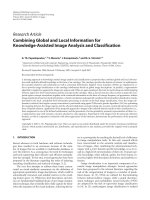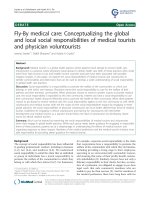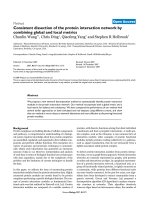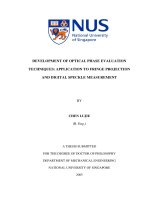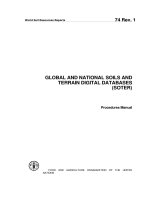global and digital marketplaces
Bạn đang xem bản rút gọn của tài liệu. Xem và tải ngay bản đầy đủ của tài liệu tại đây (103.28 KB, 18 trang )
TABLE OF CONTENTS
Abstract.................................................................................................................................1
Topic 1 Reflections: Global Marketspace and Virtual Networking: Web 2.0
revolution..........................................................................................................................2
1.
Key concepts learned.....................................................................................2
2.
Achievement in learning................................................................................2
3.
Evidence of learning.......................................................................................2
4.
Assessment of learning...................................................................................3
5.
Relevance of learning.....................................................................................3
Topic 2 Reflections: Social media and the global marketplace: Web 2.0 Business
models...............................................................................................................................3
1.
Key concepts learned.....................................................................................3
2.
Achievement in learning................................................................................4
3.
Evidence of learning.......................................................................................4
4.
Assessment of learning...................................................................................4
5.
Relevance of learning.....................................................................................4
Topic 3 Reflections: Global Consumers in the global marketplace: the power of
web 2.0..............................................................................................................................4
1.
Key concepts learned.....................................................................................4
2.
Achievement in learning................................................................................5
3.
Evidence of learning.......................................................................................5
4.
Assessment of learning...................................................................................5
5.
Relevance of learning.....................................................................................5
Topic 4 Reflections: Global Consumer Culture and constructing consumer
identities in the global marketplace...............................................................................6
1.
Key concepts learned.....................................................................................6
2.
Achievement in learning................................................................................6
3.
Evidence of learning.......................................................................................6
i
4.
Assessment of learning...................................................................................7
5.
Relevance of learning.....................................................................................7
Topic 5 Reflections: Integration and Fragmentation of the Global Marketplace.....7
1.
Key concepts learned.....................................................................................7
2.
Achievement in learning................................................................................7
3.
Evidence of learning.......................................................................................7
4.
Assessment of learning...................................................................................8
5.
Relevance of learning.....................................................................................8
Topic 6 Reflections: Researching the global marketplace...........................................8
1.
Key concepts learned.....................................................................................8
2.
Achievement in learning................................................................................9
3.
Evidence of learning.......................................................................................9
4.
Assessment of learning...................................................................................9
5.
Relevance of learning.....................................................................................9
Topic 7 Reflections: Managing Global Business Reputation in the global
marketspace.....................................................................................................................9
1.
Key concepts learned.....................................................................................9
2.
Achievement in learning..............................................................................10
3.
Evidence of learning.....................................................................................10
4.
Assessment of learning.................................................................................10
5.
Relevance of learning...................................................................................10
Topic 8 Reflections: Developing IT-enabled strategies to exploit global
marketplace opportunities............................................................................................10
1.
Key concepts learned...................................................................................10
2.
Achievement in learning..............................................................................11
3.
Evidence of learning.....................................................................................11
4.
Assessment of learning.................................................................................11
5.
Relevance of learning...................................................................................11
ii
Overall conclusions............................................................................................................12
References...........................................................................................................................13
iii
Abstract
In the digital and global marketplace era, businesses must have deep knowledge of
digital business platforms and capabilities to adapt to constantly changing business
environments to ensure growth and sustainability. The scope of the global marketplace
management is quite large and keeps changing, requiring enterprises' dynamics and
innovation (Spais, Beheshti & Rana, 2019)
1
Topic 1 Reflections: Global Marketspace and Virtual Networking: Web 2.0
revolution
1.
Key concepts learned
The web 2.0 revolution brings various new concepts to the business context,
including global market space, global marketplace, social media, social presence and social
processes. These concepts contribute significantly to establishing virtual networking where
buyers and sellers can interact and purchase more actively (Zhang, Liu & Yao, 2021).
The global marketplace can be understood as an international business platform
where all businesses worldwide can interact continuously without geographic barriers.
Social media is identified as all communication tools helping companies better
reach and approach their customers via technological devices on social network platforms.
Social presence theory illustrates how digital interaction on social media platforms
influences customers' feelings and purchase decision-making.
Social processes consist of the progress of users and community forming and
nurturing interaction for social relationship establishment (Helsen, 2019).
2.
Achievement in learning
Throughout this lesson, it is undeniable that the web 2.0 revolution has had an
intensive influence on the operational manner of international business. In addition to the
traditional business operation, the web 2.0 revolution with social media platforms and its
constant interaction has shaped a powerful virtual networking in which all business
transactions become much easier and more profitable. As a result, it is a common trend for
global enterprises to put a complex investment in digitalization and social media as their
key business channels for revenue-driving and sustainability.
3.
Evidence of learning
It is widely accepted that the web 2.0 revolution has contributed significantly to
consumer social networking with various sites such as Myspace.com, Instagram,
Facebook, and Tiktok. In addition, more and more business-based sites such as LinkedIn
and Visible Path are highly effective in stimulating sales and marketing for higher
performance. In the digitalization era, businesses are virtual networks for selling products
and establishing other capitals for business growth.
2
4.
Assessment of learning
From our experience, it is widely agreed that web 2.0 has dramatically changed our
shopping behaviour. Thanks to the digital business environment, customers can shop more
conveniently and safely via brands' websites or applications instead of coming to their
stores, which helps us save lots of money and time. In addition, web 2.0 makes it easier for
enterprises to start their global business without investing too much in establishing a giant
operation system in a foreign market.
5.
Relevance of learning
Thanks to the knowledge in this lesson, I have equipped myself with the initial
understanding to go further with my start-up idea of promoting my favourite health
product- birds nest to international markets outside Vietnam and Asia region. The
emerging development of the global digital marketplace, especially the powerfulness of
social media platforms, would be a great supporter to help my start-up realize without too
big investment capital. I can sell online without investing in setting up a showroom or
offline shop in new markets.
Topic 2 Reflections: Social media and the global marketplace: Web 2.0
Business models
1.
Key concepts learned
Social capital is how enterprises take advantage of their social relationship to gain
other capital for business operations.
The social theatre illustrates enterprises' efforts and attitudes in cooperation with
consumers to stimulate higher business efficiency.
Far more different from the traditional business concept in which globalization is
considered a step-by-step procedure, the "born-global" businesses emphasize on ceaseless
creation of advantages and resources for driving global sales and revenue (San Emeterio,
Juaneda-Ayensa & Fernández-Ortiz, 2020).
The most common web 2.0 business model is the 4C, with four layers referring to
Internet business function, including connection, content, context and commerce layer
(Gomes et al., 2018). Depending on their feature, these layers would contribute differently
to the overall business performance at different stages.
3
2.
Achievement in learning
After this lesson, I fully understood the essence of investing in building and
developing social media platforms among global businesses. These investments would
ensure their sound interaction and social relationship establishment with a more significant
customer base for more decisive business operations and revenue gained.
3.
Evidence of learning
Following the merge of the web 2.0 revolution, various e-commerce websites
launched to help customers shop more conveniently and effectively, such as Amazon, Tiki
and Shopee. In addition to e-commerce websites, many social media platforms allow both
virtual networking and business stimulation, such as Instagram, Facebook and Tiktok.
4.
Assessment of learning
This lesson is quite knowledgeable and helpful to help us set up a more
digitalization business mindset. Accordingly, despite what products and business types we
are thinking about, digital business with a deep focus on social media platforms would be a
must for a good start. The investment in a digital business or transforming from a
traditional business into a digital business would result in a higher return on investment
more quickly compared to starting with a traditional business thanks to the mass and
intensive impacts of virtual social networking on customers' purchase decision-making
process.
5.
Relevance of learning
Once again, socializing my bird nest business on social media would be pretty
profitable. The design of a new website, and social media accounts on leading platforms,
including Facebook, Tiktok, and some top e-commerce sites such as Shopee or Tiki, would
allow me to better approach a more extensive customer base for social presence
establishment prior to focusing on sales and marketing.
Topic 3 Reflections: Global Consumers in the global marketplace: the power
of web 2.0
1.
Key concepts learned
According to Shuen (2018), the appearance of web 2.0 has brought lots of benefits
to both customers and enterprises, including:
-
Allow customers to search for information much more quickly and
conveniently on various web application
4
-
Enable enterprises to better approach bigger audiences via targeted and
tailored content, including both marketing and promotion types
-
Ensure a sound customer journey for a better customer experience while
purchasing online.
2.
Achievement in learning
This lesson helped us become more knowledgeable about the trend of
digitalization. The traditional business model is getting less effective than digital ones due
to their limitations on operational scope and interaction with customers in different
countries. However, with the digital marketplace, there is no limitation on space gap as a
brand can reach all customers worldwide with good content and marketing strategies
targeted at a specific audience group. In addition, from the perspective of consumers, they
also find digital shopping much more convenient than coming to the shop resulting in their
growing demands for online shopping with more social interaction with brands.
3.
Evidence of learning
Considering the case of Tiktok, far more different from its initial position as a
social network platform allowing users to create and share creative content for social
networking promotion, nowadays, many individuals and brands can earn passive income
from this platform via the function of businesses. Users can now buy everything from
Tiktok, from food and household appliance to cosmetics or even land and houses. In other
words, social media transform business operations, making it more flexible and profitable.
4.
Assessment of learning
After this lesson, I realize the close relationship between the content and
effectiveness of business on social media platforms. The more engaging content is, the
better a brand can approach customers, driving sales revenue.
5.
Relevance of learning
Thus, I would explore the most attractive content strategy for my bird nest business
on social platforms. As these are considered premium healthcare products, I need to define
the suitable customer base to develop and deliver the most engaging and tailored content to
call for their attention, then ensure the sale conversion rate and revenue.
5
Topic 4 Reflections: Global Consumer Culture and constructing consumer
identities in the global marketplace
1.
Key concepts learned
Hofstede's cultural dimension theory is considered the most popular framework for
national culture in which the interpersonal relationships at work in different countries are
affected differently by the local cultures and values (Jadil et al., 2022).
Speaking of consumer culture, it is everything relevant to the customers'
consumption, including demands, expectations and characteristics.
Consumer identity can be understood as their shopping behaviour while
considering a product or brand. Factors such as consumer characteristics and values may
influence consumer identities, including internal factors. and external including brand
reputation, price, and community reviews. (Grewal, Stephen & Coleman, 2019)
2.
Achievement in learning
Combining the knowledge provided in this lesson and the actual macro
environment of the world after COVID-19, it can be said that global consumer identities
have been changed a lot by external factors. They are becoming more price sensitive due to
limited compensation capability resulting in their careful consideration prior to purchasing
decision-making. This proves the right of the knowledge provided in this section.
3.
Evidence of learning
Consumer identities in the international marketplace are constructed by four
influential factors, including cultural, social, individual and psychological factors. In order
to ensure an accurate understanding of customer persona for effective marketing and sale
strategy, it is a must for enterprises to sufficiently review the four-factor groups. The
missing evaluation of any factor would lead to wrong customer understanding affecting the
effectiveness of business strategy negatively. For instance, while responding to the green
consumption trend in the global market, fast fashion brands such as H&M or Zara should
have taken notes about their target customers' identity, who are young and knowledgeable.
They are highly demanding information authenticity resulting in their concerns about the
"green" of these brands. Meanwhile, in some cases, these brands failed to provide their
customer community with solid evidence for their green manufacturing. They have been
confronted with hostile protests affecting their brand identity in the market.
6
4.
Assessment of learning
From my perspective, I have to admit that the construction of global consumer
identities is quite challenging as they come from various cultures with a diversified
backgrounds. Thus, prior to entering any new market, it is critical for enterprises to
conduct market research to gain enough customer personas and market insights for safe
investment.
5.
Relevance of learning
With the trend of online shopping and digitalization, more and more customers are
demanding personalization. This is also a big trend for enterprises to well note during their
business R&D and global launching to avoid the mismatch between their delivered
messages and the market's actual needs. Similarly, in my case of promoting my bird nest
business, I must conduct market research to decide on the most potential market to start
with a clear target audience persona.
Topic 5 Reflections: Integration and Fragmentation of the Global Marketplace
1.
Key concepts learned
Even though globalization is a trend and has changed business operations
worldwide noticeably, while operating business in an international scope, it is essential for
businesses to consider both integration and fragmentation of the global marketplace to
avoid business disruption or failure.
The fragmentation of the global marketplace refers to the division of the global
market into different pieces in which consumer culture and identity vary differently. As a
result, enterprises have to pay attention to the smallest unit of their business procedure to
ensure their alignment with the whole but maintain suitability with their niche market
(Oleksiyenko, 2019).
2.
Achievement in learning
This lesson emphasized the necessity to ensure integration and fragmentation
features in the business plan while operating in the global marketplace. This combination
effectively makes brands more flexible and adaptive to the constantly changing business
environment.
3.
Evidence of learning
Take a look at the case of McDonald's entry into Vietnam. Due to their dearth of
Vietnamese customers' insights and the fragmentation of the fast-food industry in Vietnam,
7
their business seems less successful than expected. Accordingly, despite the emerging
Vietnamese trend of using fast food, their utilization of hamburgers and other dishes on
McDonald's menu needs to be improved; and their consumption level. In other words,
Vietnamese people are only willing to pay less than McDonald's price for a fast-food
service. In addition, they expect a more tailored taste instead of the original American taste
provided by the brand.
4.
Assessment of learning
I also listened to one of my classmates sharing her experience about balancing both
integration and fragmentation of the global marketplace. According to her story, one of her
friends used to open a franchise of Ding Tea- a relatively famous Taiwan tea brand in
Vietnam in her hometown. This franchise failed after three months of operation because
customers in her hometown could not afford the drinks' price despite their genuine interest
and love for the drinks. This is strong evidence of the failure due to the mismatch between
the integration and fragmentation of the market.
5.
Relevance of learning
In my case of promoting bird nest, it would be crucial for me to reasonably evaluate
the actual demand and willingness to pay off the target audience to ensure success due to
their incapability of payment regardless of their real product demand and interest.
Topic 6 Reflections: Researching the global marketplace
1.
Key concepts learned
The process of gathering data about the market for insights and market trend
prediction is known as the research process.
While conducting market research, mainly about the global marketplace, sentiment
analysis is among the most popular as it is used to measure customers' emotions towards a
product or brand in the defined context.
In addition, brands can make use of emic and etic approaches to gain their expected
results. Depending on different needs, companies can use an emic or etic approach. The
emic approach would result in results based on participants' perspectives. In comparison,
the etic approach would explore the adoption of existing theoretical frameworks in the
context with fewer influences by research participants' perspectives (Hansen & Heu, 2020).
8
Market research would contribute noticeably to the establishment of big data for the
company, which consists of large and complex data about customers, brands and the
market, which supports better decision-making.
2.
Achievement in learning
After this lesson, I was clear about the critical role of market research in business.
Thanks to the results from business research, enterprises can make a better decisions for
business driving and sustainability. In addition, I also understand some most common
research approaches to ensure the exactness of gathered data.
3.
Evidence of learning
It is undeniable that market researches are highly effective in driving better
business strategy decision-making. Once the gathered data is exact and reliable, it will
stimulate innovative business initiatives for higher revenue. Take a look at the case of
Coca-Cola in Vietnam. As they got the insight into the high demand for gathering and
reunion of Vietnamese, especially in special events and holidays, their central theme for
Tet always focuses on family and reunion that catch customers' emotions, then driving
sales noticeably. In addition, Coca-Cola is always active in social presence to better
approach a mass audience, including children, teenagers, and adults.
4.
Assessment of learning
From the case of Coca-Cola, it is undeniable that market research is a must for all
businesses while entering a market. It guides the business procedure and supports the
business's adaptation to stay aligned with the market-changing demands and context.
5.
Relevance of learning
Considering my intention of selling bird-nest to another country, it is necessary for
me to explore more premium suppliers to make my products appealing to high-end
customers who have higher compensation efforts and willingness to pay compared to my
current customer base, who are middle-class.
Topic 7 Reflections: Managing Global Business Reputation in the global
marketspace
1.
Key concepts learned
According to Steenkamp (2020), two of the most valuable assets of enterprises are
reputation and brand. These assets require regular nurturing and control for sustainability.
Brand reputation can be understood as all of the brand's business functions and activities
9
for promoting product selling and brand presence benchmarking on the market for
acquiring and engaging customers longer and longer.
2.
Achievement in learning
Via the lesson, it is clear to all of us that good reputation management is critical to
business establishment and development as it directly affects customers' perception of the
products and services that a brand provides. Sound brand reputation management also
helps orientate business and make it more adaptive to market changes for effective
maintenance of market position.
3.
Evidence of learning
In digitalization, brand reputation management must be conducted online and
offline to ensure brand consistency. In addition, the online reputation also requires higher
concentration due to the fast viral on online media platforms. In the world, various case
studies are losing their market due to inappropriate online reputation control. The viral
video recording staff of McDonald's beating customers was abundant evidence of the
brand's incapability of brand reputation management resulting in this brand's boycott in
that market.
4.
Assessment of learning
After this lesson, most of my classmates agreed that online brand reputation
management is increasingly important in protecting business, especially in the era of social
media platforms and the trend of reviewing. It is highly recommended that brands develop
their own brand reputation management practice to in-timely respond to the threats and
scandals online to eliminate and minimize their adverse impacts on brand reputation and
presence.
5.
Relevance of learning
Based on this lesson, I also put stress on designing my feedback management
procedure to deal with negative feedback and complaints from my future customers to
maintain my brand's rank and online presence.
Topic 8 Reflections: Developing IT-enabled strategies to exploit global
marketplace opportunities
1.
Key concepts learned
It is undeniable that the advanced technology has supported the business strategies
and implementation design noticeably. Once enterprises have the capability of IT and
10
resource for implementing cutting-edge technologies in their business procedures, they will
achieve apparent success (Nambisan, Zahra, & Luo, 2019). To some extent, IT would help
to leverage operational efficiency and brand competitiveness.
2.
Achievement in learning
This lesson teaches us the influential role of IT applications in business
performance optimization. It can be said that IT resource and capability is also a strong
competitive advantage of companies in the global marketplace as they would make
marketing and sale more effective via sound integration of online payment methods, digital
marketing tactics, and customer service optimizations such as chatbot.
3.
Evidence of learning
Some friends operating online clothing businesses adopted chatbots for their
Facebook fan pages. They found it quite convenient, especially with the everyday concerns
of customers about product categories and prices. However, with the further need for
consultancy, they found that the chatbot needed improvement.
4.
Assessment of learning
It is an emerging trend for businesses to adopt advanced technologies in driving
their business and development. However, in addition to the adoption, regular review and
upgrades must ensure the suitability between the technical innovation and the actual
customers' demands and expectations.
5.
Relevance of learning
From my knowledge and experience, I recognize CRM as the most valuable
technological innovation that all businesses should have for their own business. With the
storage of all customer data, this would be a strategic tactic for business development and
management.
11
Overall conclusions
In a nutshell, it is compulsory for all enterprises to fully understand and well
control all global marketplace operation principles. These rules should be considered
strategic guidelines for businesses to better target and approach the most potential
customer base for sound business performance. In addition, the master control of the brand
on social media platforms would also be the top priority for a brand to stay competitive in
the market in digitalization.
12
References
Gomes, J. F., Iivari, M., Ahokangas, P., Isotalo, L., Sahlin, B., & Melén, J.
(2018). Cyber security business models in 5g. A Comprehensive Guide to 5G Security, 99116.
Grewal, L., Stephen, A. T., & Coleman, N. V. (2019). When posting about products
on social media backfires the negative effects of consumer identity signaling on product
interest. Journal of Marketing Research, 56(2), 197-210.
Hansen, N., & Heu, L. (2020). All human, yet different: An emic-etic approach to
cross-cultural replication in social psychology. Social Psychology, 51(6), 361.
Helsen, K. (2019). Digital marketing in the global marketplace: Latest
developments.
Jadil, Y., Jeyaraj, A., Dwivedi, Y. K., Rana, N. P., & Sarker, P. (2022). A
meta-analysis of the factors associated with s-commerce intention: Hofstede's cultural
dimensions as moderators. Internet Research.
Nambisan, S., Zahra, S. A., & Luo, Y. (2019). Global platforms and ecosystems:
Implications for international business theories. Journal of International Business Studies,
50(9), 1464-1486.
Oleksiyenko, A. V. (2019). Academic collaborations in the global marketplace.
Cham: Springer.
San Emeterio, M. C., Juaneda-Ayensa, E., & Fernández-Ortiz, R. (2020). Influence
of relationship networks on the internationalization process: the moderating effect of born
global. Heliyon, 6(1), e03148.
Shuen, A. (2018). Web 2.0: A Strategy Guide: Business thinking and strategies
behind successful Web 2.0 implementations. O’Reilly Media.
Spais, G., Beheshti, H., & Rana, S. (2019). Special issue on customer needs and
demand management in the global marketplace: Emerging management and marketing
practices. FIIB Business Review, 8(4), 257-258.
Steenkamp, J. B. E. (2020). Global brand building and management in the digital
age. Journal of International Marketing, 28(1), 13-27.
13
Zhang, X., Liu, H., & Yao, P. (2021). Research jungle on online consumer
behaviour in the context of web 2.0: Traceability, frontiers and perspectives in the postpandemic era. Journal of Theoretical and Applied Electronic Commerce Research, 16(5),
1740-1767.
14
